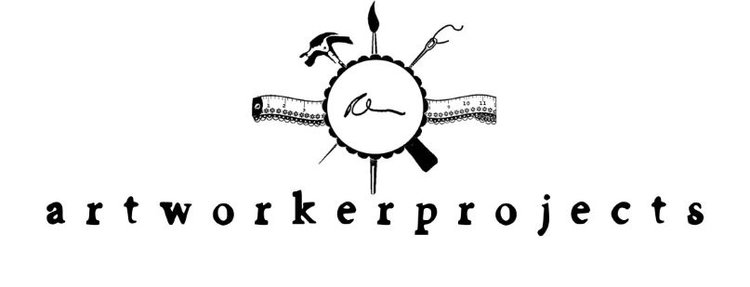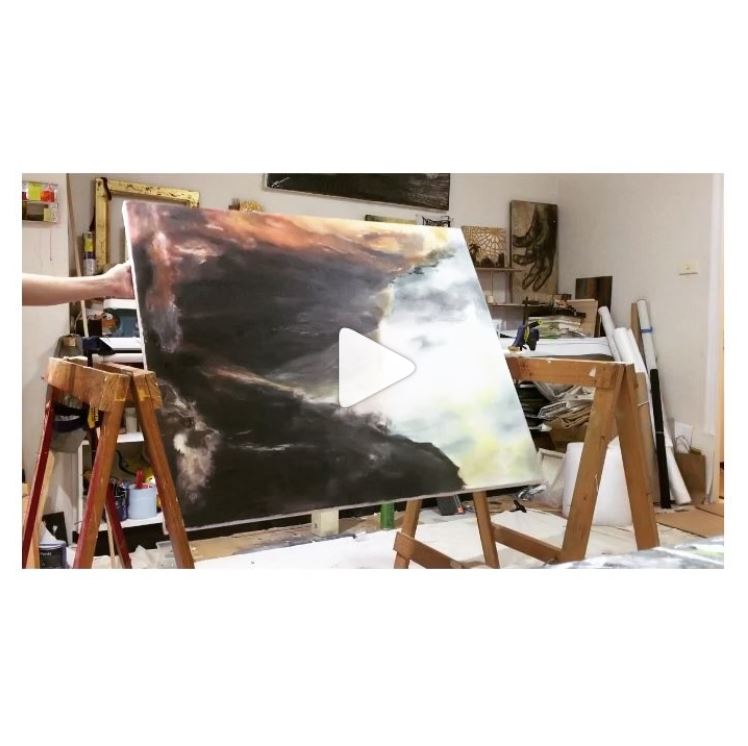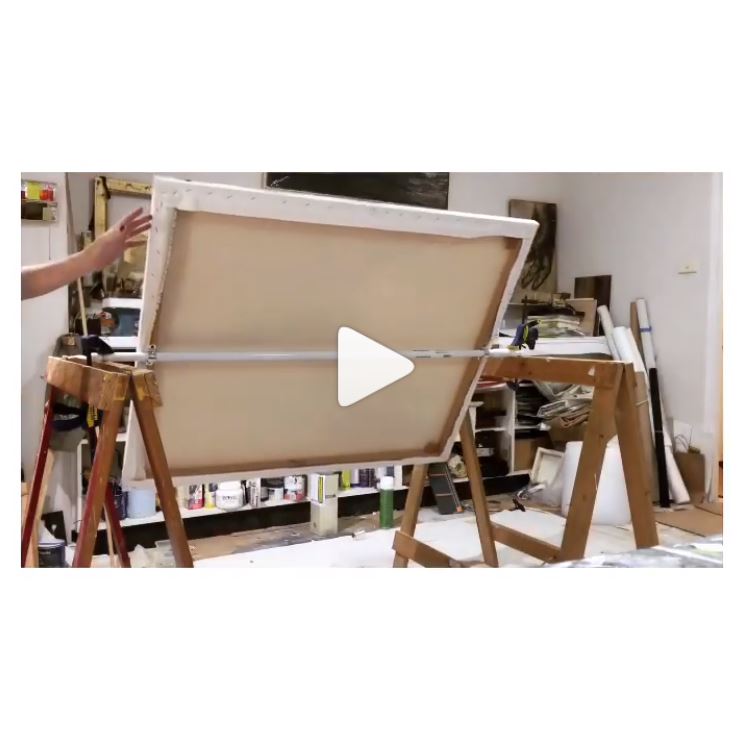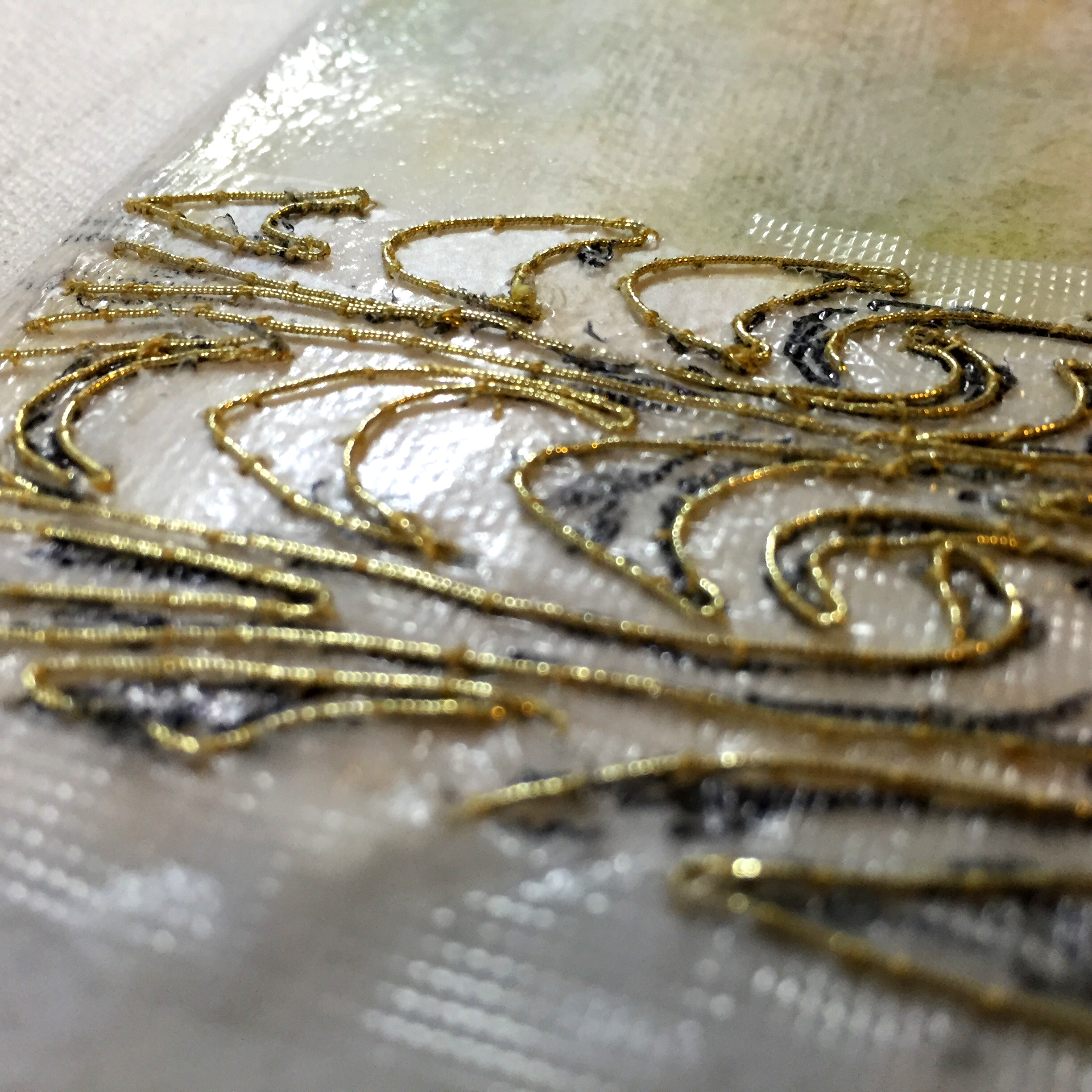A favourite subject of mine
I have learnt some things about this. I’ve embroidered quite a few pieces now and can say that the one big takeaway is: IT TAKES AGES. Big discovery. I point this out to myself here because I can tearfully vow NEVER AGAIN, having lost days & days & days to the activity, only to do it again and again because this time, I’ll be faster for sure. Not the case. I’m getting more detailed as I go & i’ts developing more every time so I keep at it. I am faster too but still, AGES…
This 600mm x 600mm stretched canvas is the largest piece I’ve embroidered via traditional methods (I’m not in Traditional Land anymore), that being DMC metallic thread couched with rayon. Couching is like strapping a feature thread onto the surface of whatever, by laying that feature thread across the surface following a predetermined design, then taking a fine thread over & around it, down through the surface & back up again, thereby tying it onto the surface, so the feature thread doesn’t look stitched, it sits proud & makes a fluid, smooth line
Here it must be said that in any discussion about embroidery there is One God, and she is Mary Corbet. Mary knows everything, all the kinds & all the ways and she explains couching thusly
Goldwork thread$
Actual traditional gold thread embroidery is called ‘Goldwork’ (*see footnote) and it is beautiful and costly and time intensive and particular and exacting. Goldwork threads are expensive and tricky to work and for my purposes at the beginning of my gold thread couching life, the DMC metallic is a good start. Yes, its a little crafty & gaudy but thats its own kind of loveable and inexpensive, which matters because man you can burn through this stuff. My only real concern with it remains that the textured look of the weave is counter to my vision. I dont want a woven thread look, I want a powerline of gold, a seam of it but I do have to say, the bumpy woven strands do catch the light nicely
I get finely detailed with lots of couching stitches to maintain the hand drawn quality and a sensitivity to line. They are like staples binding the metallic thread to the canvas surface in a non-robot way
Getting the tension right is critical. The methodology is easy, drawing the design onto Solvy, then stitching through that, then washing the Solvy away when its complete. But the thing is, I have to gamble on allowing for shrinkage of the canvas from the water exposure & this can only be done by trial & error as seen above. Left pic is an early one. The shrinkage of the canvas pulled the stitches in tightly so every stitch was taut & it looks really shrunken & mean. This gave me soul deep sadness, it actually shrieks as it shrinks (it doesn’t really, but I did) That was hours and hours and time. Ruined. Pic at right: I got better at it!
Acrylic, pastels on gold metal leaf, fiberglass mesh, DMC thread on stretched canvas 400x400mm
I used a lasso to pull the gold thread to the wrong side at the beginning and end of a line & my advice there is to press an awl into the that finish point to just ease some space, make a bit of room for the thickness of gold thread and couching thread to fit through as you pull them both to the back. The lasso shouldn’t be long, make it double looped & short. I stitched right up to the stretcher frame then pulled the canvas off completely, finished the stitching, then re-stapled the canvas back onto the stretcher, as seen above.
The whole business is lengthy & requires concentration & fortitude, but doesnt it look good…
As seen above, I’ve dissolved the Solvy at bottom right to check on the state of things. The metallic braid to the right is vintage Japanese thread. Being a foil wrapped around a paper core, its of no use if using Solvy. I know that now.
Pretty, isnt it
I came up with a device to spin a big canvas because both sides are used more or less equally when stitching and flipping it every time is an unworkable situation. Two sawhorse/trestles, some conduit clips, a broom handle and around around she goes. The pics above are clickable links to an Instagram post showing it in action. Very simple, perfect solution.
The look I really wanted & the reason for making these smaller works as seen above was to create seamless gold cording at large scale, where it becomes sculptural, a relief sculpture as well as a drawing. Click on any to bring them up closer. Machine embroidery also explored but not extensively, it’s not the way I’m going.
Et In Arcadia Ego seen here at night when the electric light makes all the shiny
The biggest piece I’ve made so far was 2x2 meters square it was quite the challenge. I gilded 2mm plastic tubing like there was no tomorrow. Its a wretched thing, gilding tubing.
Click to enlarge
I tried many methods to achieve this kind of sculptural drawing and to do so in an economic way, but I still have an annoying, niggling feeling that there’s something, some as-yet undiscovered technique for really acing this that’s just out of reach & that I’ll kick myself for not having found it sooner. Still thinking. I have a new project in mind which is why I’ve done this re-visit but none the wiser yet. This kind of thing is the kind of thing that develops when actually in the process so I’ll just have to start & see how goes. Annoying though.
Because I think this is scraping the surface. I’ve followed leads but its far from refined. The pins turned out to be the least visible method of attaching the gold which saved a shit load of time but that’s not the aesthetic I’m after. I want them fixed, not stuck, and I want it almost invisible. Glue wont cut it either, the lines are too detailed & it doesn’t feel right.
But I’m on it, go and have a lie down & I’ll see you later, fill you in.
In Australia, go here to purchase all things goldwork & experience the growing feel of hopelessness in calculating how much it’ll cost to do a project such as this with the Good Stuff. Then go to Spotlight or online & buy DMC. Its entry point gear. But you’ve been ruined, ruined forever because now you know Good Stuff.







































